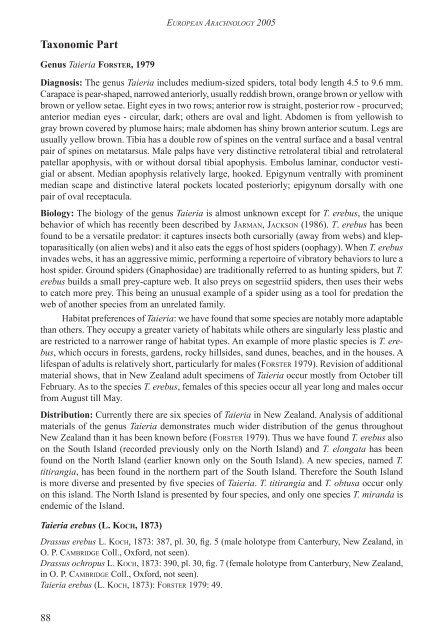Ovtsharenko VI, Fedoryak MM & Zakharov BP - European Society of ...
Ovtsharenko VI, Fedoryak MM & Zakharov BP - European Society of ...
Ovtsharenko VI, Fedoryak MM & Zakharov BP - European Society of ...
You also want an ePaper? Increase the reach of your titles
YUMPU automatically turns print PDFs into web optimized ePapers that Google loves.
Taxonomic Part<br />
Genus Taieria Forster, 1979<br />
88<br />
EuropEan arachnology 2005<br />
Diagnosis: The genus Taieria includes medium-sized spiders, total body length 4.5 to 9.6 mm.<br />
Carapace is pear-shaped, narrowed anteriorly, usually reddish brown, orange brown or yellow with<br />
brown or yellow setae. Eight eyes in two rows; anterior row is straight, posterior row - procurved;<br />
anterior median eyes - circular, dark; others are oval and light. Abdomen is from yellowish to<br />
gray brown covered by plumose hairs; male abdomen has shiny brown anterior scutum. Legs are<br />
usually yellow brown. Tibia has a double row <strong>of</strong> spines on the ventral surface and a basal ventral<br />
pair <strong>of</strong> spines on metatarsus. Male palps have very distinctive retrolateral tibial and retrolateral<br />
patellar apophysis, with or without dorsal tibial apophysis. Embolus laminar, conductor vestigial<br />
or absent. Median apophysis relatively large, hooked. Epigynum ventrally with prominent<br />
median scape and distinctive lateral pockets located posteriorly; epigynum dorsally with one<br />
pair <strong>of</strong> oval receptacula.<br />
Biology: The biology <strong>of</strong> the genus Taieria is almost unknown except for T. erebus, the unique<br />
behavior <strong>of</strong> which has recently been described by Jarman, JacKson (1986). T. erebus has been<br />
found to be a versatile predator: it captures insects both cursorially (away from webs) and kleptoparasitically<br />
(on alien webs) and it also eats the eggs <strong>of</strong> host spiders (oophagy). When T. erebus<br />
invades webs, it has an aggressive mimic, performing a repertoire <strong>of</strong> vibratory behaviors to lure a<br />
host spider. Ground spiders (Gnaphosidae) are traditionally referred to as hunting spiders, but T.<br />
erebus builds a small prey-capture web. It also preys on segestriid spiders, then uses their webs<br />
to catch more prey. This being an unusual example <strong>of</strong> a spider using as a tool for predation the<br />
web <strong>of</strong> another species from an unrelated family.<br />
Habitat preferences <strong>of</strong> Taieria: we have found that some species are notably more adaptable<br />
than others. They occupy a greater variety <strong>of</strong> habitats while others are singularly less plastic and<br />
are restricted to a narrower range <strong>of</strong> habitat types. An example <strong>of</strong> more plastic species is T. erebus,<br />
which occurs in forests, gardens, rocky hillsides, sand dunes, beaches, and in the houses. A<br />
lifespan <strong>of</strong> adults is relatively short, particularly for males (ForstEr 1979). Revision <strong>of</strong> additional<br />
material shows, that in New Zealand adult specimens <strong>of</strong> Taieria occur mostly from October till<br />
February. As to the species T. erebus, females <strong>of</strong> this species occur all year long and males occur<br />
from August till May.<br />
Distribution: Currently there are six species <strong>of</strong> Taieria in New Zealand. Analysis <strong>of</strong> additional<br />
materials <strong>of</strong> the genus Taieria demonstrates much wider distribution <strong>of</strong> the genus throughout<br />
New Zealand than it has been known before (ForstEr 1979). Thus we have found T. erebus also<br />
on the South Island (recorded previously only on the North Island) and T. elongata has been<br />
found on the North Island (earlier known only on the South Island). A new species, named T.<br />
titirangia, has been found in the northern part <strong>of</strong> the South Island. Therefore the South Island<br />
is more diverse and presented by five species <strong>of</strong> Taieria. T. titirangia and T. obtusa occur only<br />
on this island. The North Island is presented by four species, and only one species T. miranda is<br />
endemic <strong>of</strong> the Island.<br />
Taieria erebus (L. Koch, 1873)<br />
Drassus erebus l. Koch, 1873: 387, pl. 30, fig. 5 (male holotype from Canterbury, New Zealand, in<br />
O. P. cambridgE Coll., Oxford, not seen).<br />
Drassus ochropus l. Koch, 1873: 390, pl. 30, fig. 7 (female holotype from Canterbury, New Zealand,<br />
in O. P. cambridgE Coll., Oxford, not seen).<br />
Taieria erebus (l. Koch, 1873): ForstEr 1979: 49.
















